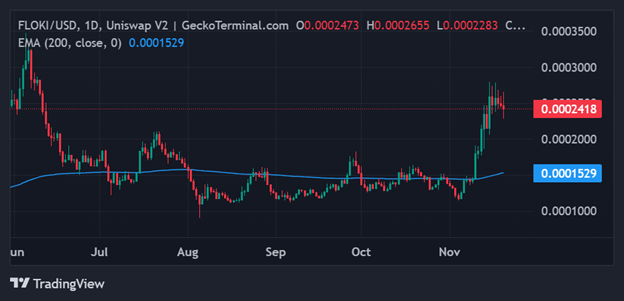- Coinbase listing FLOKI on November 21 could boost liquidity and market interest.
- Technical analysis suggests a 30% price surge if FLOKI breaks consolidation levels.
- On-chain data shows increased transaction volume, signalling a potential bullish trend.
The announcement that Coinbase will list FLOKI, a dog-themed meme coin, on the Ethereum network has sparked widespread attention. FLOKI, the sixth-largest meme coin by market capitalization at $2.3 billion, has already gained significant traction across major exchanges such as Binance and Bybit.
However, its listing on the United States’ largest cryptocurrency exchange could signal the next big step for the meme coin in both price action and broader market recognition.
Impact of upcoming FLOKI listing on Coinbase
FLOKI’s support on Coinbase, slated to open on November 21, 2024, at or after 9 am PT, is expected to provide a substantial boost to the token’s liquidity, with trading initially available on the FLOKI/USD pair.
While this announcement led to a 14% increase in FLOKI’s price earlier, the token has experienced a modest decline of over 5% in the 24 hours following Coinbase’s official confirmation. Despite this, the trading volume surged by 17%, signalling heightened market interest.
Floki price technical analysis
The technical outlook for FLOKI is showing signs of promise, as it appears poised for a breakout. On the four-hour timeframe, technical analysis reveals a descending triangle pattern, which suggests that a potential upward move could be on the horizon.
Experts predict that if FLOKI breaks out of its current consolidation range between $0.000232 and $0.000275, the meme coin could see a 30% price surge, potentially reaching the $0.00035 level in the coming days.
The 200 Exponential Moving Average (EMA) also signals that FLOKI remains in an uptrend, with its price consistently trading above this critical level.

FLOKI’s technical indicators aren’t the only bullish signs. On-chain data reveals a sharp increase in large transactions for meme coins, with a notable 98% surge in SHIB’s transaction volume, driven by whales and institutional investors.
However, FLOKI’s open interest dropped by 12% on November 20 according to Coinglass, suggesting that traders might be waiting for a breakout to position themselves for a potential rally.
As the date for Coinbase’s listing approaches, FLOKI’s future looks promising. With the right technical momentum and broader market interest, FLOKI could be on the verge of significant price action, making it a token to watch closely in the coming weeks.
The post Possible Floki price breakout on the horizon after Coinbase listing appeared first on CoinJournal.
